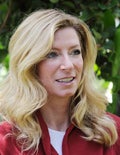It’s a historic moment in Hollywood: "Hurt Locker" director Kathryn Bigelow is favored to take home an Oscar after a season filled with awards and critical acclaim for her Iraq war movie.
But for other female directors, 2009 was a terrible year.
Already in the single digits of Hollywood’s directors, women actually lost ground on the directing front last year, accounting for just 7 percent of directors on the 250 top-grossing movies of 2009 — a drop of 2 percent.
 That’s the same number as in 1987, according to Martha M. Lauzen’s annual study "The Celluloid Ceiling," released Tuesday.
That’s the same number as in 1987, according to Martha M. Lauzen’s annual study "The Celluloid Ceiling," released Tuesday.
Overall, women made no gains in employment behind-the-scenes from the top 250 films of 2008 to those of 2009.
Last year women comprised 16 percent of all directors, producers, executive producers, writers, cinematographers and editors on Hollywood’s top-grossing films, according to “The Celluloid Ceiling,” released Tuesday by Lauzen (left), executive director of the Center for the Study of Women in Television and Film at San Diego State University.
Lauzen, who has been conducting the study for a number of years, found behind-the-scenes roles for women were unchanged from 2008 and down 3 percent from 2001.
The study counted 2,838 people working on the 250 top-grossing domestic films of 2009, with combined domestic box office of about $10.5 million.
The representation of women was greatest among producers, where they accounted for 23 percent, unchanged from 2008. However, 35 percent of 2009’s top films had no female producers at all.
Women also comprised 17 percent of executive producers in 2009, up a bit from 16 percent in 2008. However, two-thirds of the movies had no female executive producers.
The area where women are least represented was cinematography; only 2 percent of the 250 films credited female cinematographers. That’s the same figure as in 2007, although in 2008 the number was 4 percent.
Editing was the technical area with the most women employed. Women accounted for 18 percent of all editors working on the top 250 films of 2009. However, 78 percent of those films had no women in the editing suite. In 2008, women accounted for 17 percent of editors on the top 250 films.
And among writers, the statistics were dismal: Only 8 percent of writers were female, and 86 percent of the films had no female writers credited. In 2008, 12 percent of credited writers were female, and 82 percent of the films had no female writers.
Lauzen’s comparison of the same categories in 1998 and 2009 showed slight declines in all areas, with writing the area where employment of women has declined the most.
A report in October from the Center for the Study of Women in Television and Film showed the numbers for women were better on what Lauzen dubbed "festival films" than on studio films: 24 percent to 16 percent. However, the numbers still don’t come close to being representative of the general population, which is more than 50% female.


